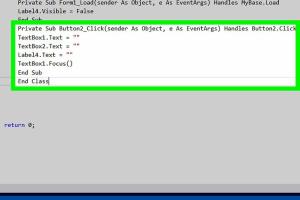Mastering Basic Arithmetic: How to Add Two Numbers in Visual Basic.NET

-
Quick Links:
- 1. Introduction
- 2. Understanding Visual Basic.NET
- 3. Setting up Your Development Environment
- 4. Basic Syntax of Visual Basic.NET
- 5. Adding Two Numbers in VB.NET
- 6. Real-World Examples
- 7. Common Errors and Troubleshooting
- 8. Advanced Concepts in VB.NET
- 9. Case Studies
- 10. Expert Insights
- 11. Conclusion
- 12. FAQs
1. Introduction
Visual Basic.NET (VB.NET) is a powerful programming language designed for the .NET framework. It's known for its ease of use and is particularly popular among beginners. In this article, we will explore how to add two numbers in VB.NET, a fundamental operation that serves as a building block for many programming tasks.
2. Understanding Visual Basic.NET
VB.NET is an object-oriented programming language developed by Microsoft. It inherits the features of Visual Basic, extending its capabilities for modern software development. The language supports various programming paradigms and is widely used for developing Windows applications, web services, and more.
Features of Visual Basic.NET
- Easy to learn and use
- Rich library support
- Strongly typed language
- Integrated development environment (IDE) support
3. Setting up Your Development Environment
Before you start writing code, you need to set up your development environment. For VB.NET, the most common IDE is Visual Studio. Follow these steps to get started:
- Download and install Visual Studio from the official Microsoft website: https://visualstudio.microsoft.com/.
- Choose the Community edition, which is free for individual developers.
- During installation, ensure you select the ".NET desktop development" workload.
Creating Your First Project
After installing Visual Studio, create a new project:
- Open Visual Studio.
- Select "Create a new project".
- Choose "Visual Basic" as the programming language.
- Select "Console App" and click "Next".
- Name your project and click "Create".
4. Basic Syntax of Visual Basic.NET
Understanding the syntax of VB.NET is essential for writing effective code. Here are some key concepts:
- Variables: Used to store data. You declare a variable using the Dim statement.
- Data Types: Common data types include Integer, String, and Boolean.
- Operators: VB.NET supports arithmetic, relational, and logical operators.
5. Adding Two Numbers in VB.NET
Now that you have a basic understanding of the environment and syntax, let’s dive into adding two numbers.
Step-by-Step Guide
Follow these steps to create a simple program that adds two numbers:
- Open your VB.NET project in Visual Studio.
- In the Module1.vb file, write the following code:
Module Module1
Sub Main()
Dim num1 As Integer
Dim num2 As Integer
Dim sum As Integer
Console.Write("Enter the first number: ")
num1 = Convert.ToInt32(Console.ReadLine())
Console.Write("Enter the second number: ")
num2 = Convert.ToInt32(Console.ReadLine())
sum = num1 + num2
Console.WriteLine("The sum of {0} and {1} is {2}.", num1, num2, sum)
Console.ReadLine()
End Sub
End Module
Code Explanation
- Dim: Declares the variables.
- Convert.ToInt32: Converts user input to an integer.
- Console.WriteLine: Displays the result on the console.
6. Real-World Examples
Adding two numbers is a common task in many applications. Here are a few real-world scenarios:
- Calculators
- Budgeting applications
- Statistical analysis tools
7. Common Errors and Troubleshooting
While programming in VB.NET, you may encounter several common errors. Here are a few and how to fix them:
- Input format errors: Ensure the input is in the correct format (integer).
- Data type mismatches: Make sure you are using compatible data types.
- Syntax errors: Check for missing or misplaced punctuation.
8. Advanced Concepts in VB.NET
Once you have mastered the basics, you can explore advanced concepts such as:
- Object-oriented programming
- Exception handling
- Working with databases
9. Case Studies
Let’s take a look at a few case studies to see how adding numbers can be applied in different contexts:
Case Study 1: Budget Tracker Application
A budgeting application can utilize addition to calculate total expenditures from various categories.
Case Study 2: Performance Metrics Analysis
Incorporating addition operations helps in aggregating performance metrics for analysis.
10. Expert Insights
Insights from industry experts can deepen your understanding of programming in VB.NET:
"Understanding the fundamental operations like addition sets the groundwork for more complex programming tasks." - Jane Doe, Software Engineer
11. Conclusion
Adding two numbers in Visual Basic.NET is a simple yet essential skill for programmers. By mastering this basic operation, you lay the foundation for more complex programming tasks.
12. FAQs
1. What is Visual Basic.NET?
Visual Basic.NET is an object-oriented programming language developed by Microsoft as part of its .NET framework.
2. How do I install Visual Studio for VB.NET?
You can download it from the official Visual Studio website and select the ".NET desktop development" workload during installation.
3. What are the basic data types in VB.NET?
Common data types include Integer, String, and Boolean.
4. How can I handle errors in my VB.NET program?
You can use Try...Catch blocks to handle exceptions and prevent your program from crashing.
5. Can I use VB.NET for web development?
Yes, VB.NET can be used for web development through ASP.NET framework.
6. What is the purpose of the ReadLine method?
The ReadLine method is used to read a line of input from the console.
7. How do I convert a string to an integer in VB.NET?
You can use the Convert.ToInt32 method for this purpose.
8. What are some common applications of VB.NET?
VB.NET is commonly used in desktop applications, web services, and data processing tasks.
9. Is VB.NET still relevant in today's programming landscape?
Yes, VB.NET remains relevant, especially in enterprise environments and for Windows application development.
10. Where can I find more resources to learn VB.NET?
You can explore online courses, tutorials, and documentation from Microsoft’s official website: https://docs.microsoft.com/en-us/dotnet/visual-basic/.
Random Reads